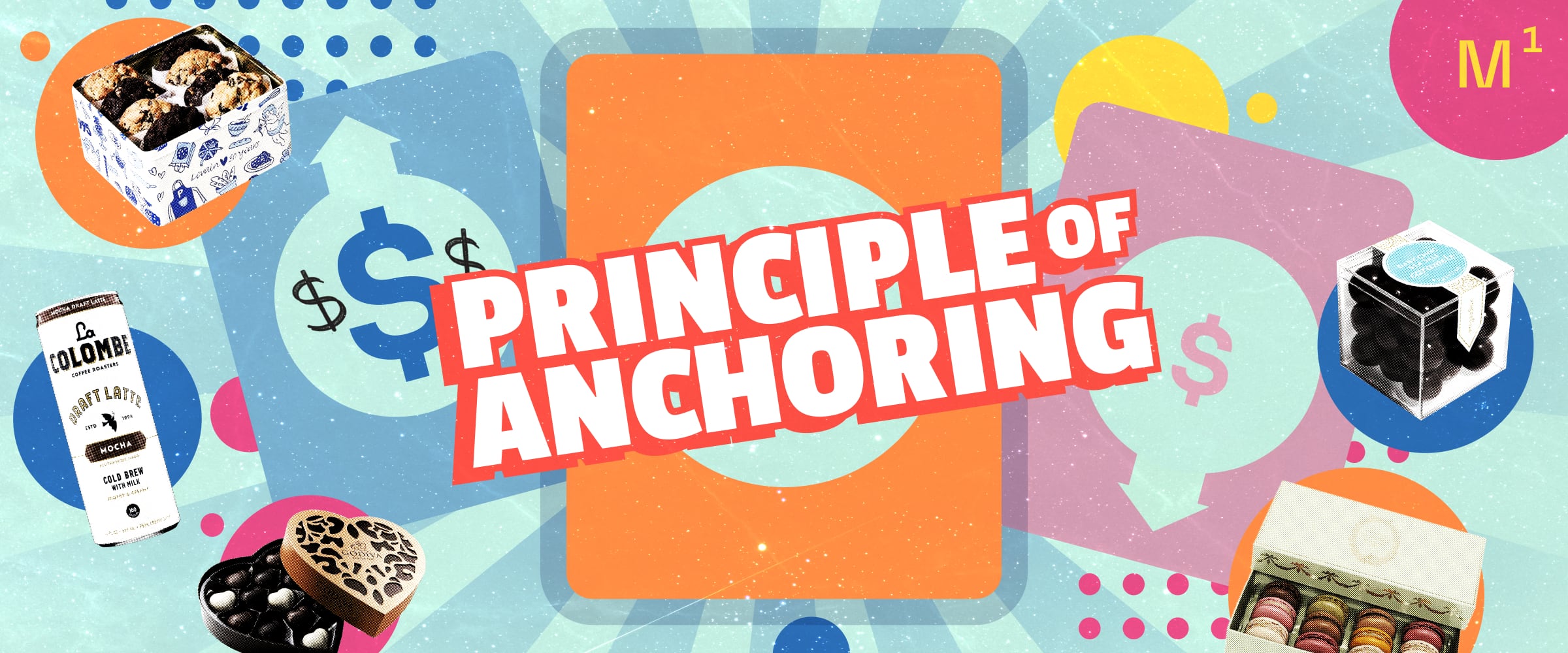
Why Your Premium Pricing Feels Expensive
Your gin scores 95 points and received two gold medals, far outperforming pricier bottles. Your chocolate uses single-origin cacao that puts mass market bars to shame. Yet when customers see your shelf tag, they hesitate.
You know the pricing reflects the true value of the experience you offer. So why the resistance?
For indulgence brands, the challenge is particularly frustrating. You've invested in quality ingredients and craftsmanship. You have a product that doesn’t just serve a practical function but delivers moments of joy.
The problem isn't your price. It's the absence of “anchoring”—providing the greater context consumers need to make your price feel perfectly reasonable.
Indulgence brands often focus on communicating quality, assuming price acceptance will follow. But without anchoring, even well-justified premium pricing feels risky—and leaves consumers unable to justify purchase.
The Behavioral Science Behind How Consumers Assess Value
Behavioral science reveals what's really happening when people (maddeningly) accept your competitor’s premium—or default to a “good enough” alternative—rather than choosing you.
Human beings never judge prices in isolation. We’re wired to perceive everything in relative terms. This makes the first number we see an important reference point—one that influences the value of whatever we see next.
It’s called the principle of anchoring, and it’s measurable.
Nobel Prize-winning behavioral expert Daniel Kahneman (with colleague Amos Tversky) ran an ingenious experiment to show how anchoring works. He invited participants to spin a wheel of fortune rigged to land on either 10 or 65. He instructed each person to read their number aloud, then asked them to estimate what percentage of UN countries are from Africa.
The results:
- Participants who landed on 10 guessed an average of 25%
- Participants who landed on 65 guessed 45%
Same question, completely irrelevant anchor, dramatically different perceptions.
Kahneman and Tversky explained it this way:
When people don't know a numerical answer, they enter a "gray zone of uncertainty." The study participants knew the percentage of African UN countries was somewhere between 0% and 100%. But they needed a point of reference—which the wheel provided. And while they deviated some, they never strayed far from the anchoring number they’d seen and spoken.
Now let’s apply this to your premium gin or chocolate bar.
Without context, your consumer may enter Kahneman’s gray zone of uncertainty. They know your product isn't free, and they probably know it's not $500. But they need a reference point to determine what feels fair.
For everyday indulgences like premium coffee or chocolate, consumers may buy the category regularly—but premium versions put them in the gray zone of uncertainty where they need more justification for the splurge. For occasional indulgences like craft spirits, the infrequency compounds the uncertainty, as it’s been so long since they last gave themselves permission.
Either way, without anchoring, even reasonable prices can trigger the same resistance.
The Behavioral Science Behind How Consumers Assess Value
If you're experiencing price resistance, these patterns can help diagnose whether anchoring is part of the problem:
- Consistent consumer feedback/comments that your products are "expensive" despite competitive quality
- Long consideration periods for premium offerings
- Strong trial conversion but poor repeat purchase at full price
- Competitors with similar pricing facing less resistance
If any of this sounds familiar, it’s time to work on some strategic anchoring—making your brand’s value cognitively easier to accept.
How to Introduce Your Anchor—and Make Your Premium Appealing
First, resist all temptation to defend or justify your premium pricing by stressing product features or benefits. That's just appealing to consumers' rational minds when behavioral science tells us (again and again) that conscious consideration requires more cognitive energy than humans prefer to spend.
Instead, focus on giving consumers the reference points that make you feel intuitively like a reasonable option before they even see your price. The key is to position your premium as the smart choice within a broader landscape, not an expensive outlier.
Consider these four approaches.
Position Against Higher Anchors
Use competitor pricing strategically to reframe your premium as accessible.
- Your $28 coffee subscription sounds reasonable when consumers know specialty roasters charge $25-$45
- Your $75 vodka becomes "mid-premium" next to $150 reserve options
Method1 client Lunazul is a 100% blue agave tequila competing against $30+ options on crowded shelves, all touting the same quality. We positioned the brand as premium without the pretense—offering an experience comparable to flashy, celebrity-driven competitors’ at a price point that feels reasonable: about $22.
It’s not about showing up your competitors on value—but it is about showing where your brand sits within the relevant spectrum of premiums.
Create Smart Tiers
Consider introducing a super-premium option that’s more expensive than your main product.
- Your $35 chocolate collection feels accessible next to your $60 limited edition
- Your $55 gin becomes the sensible choice when positioned between your $35 entry and $95 flagship
Starbucks famously uses its sizing system as an anchor. By creating Tall, Grande and Venti options (with strategic price gaps), they make the Grande feel like the smart middle choice rather than leaving customers to decide whether to “overpay” for coffee.
The top tier doesn't need to be your volume driver. (In most cases, it isn’t!) But working as an anchor, it will make your core premium feel reasonably priced.
Establish Concrete Benchmarks
Help customers understand exactly why your product sits where it does in the premium hierarchy. Often, it’s in the details—not the big promises in your slogan or campaign headlines.
- Instead of "artisanal quality," specify "single-origin beans that typically retail for $30-$40 per bag"
- Rather than "premium ingredients," reference "aged 8 years when most craft spirits age 4-6"
Rather than make vague "premium" claims, Tito’s specifies their vodka is "distilled 6 times" and "corn-based, not grain"—concrete production details that help justify their price point.
The key is making your premium positioning feel factual rather than promotional. When consumers learn about these benchmarks, your price becomes justified by category standards, not brand claims that sound like overpromising.
The most sophisticated strategies layer these approaches and more, applying behavioral principles beyond price anchoring. There are numerous, proven emotional triggers and mental shortcuts that shift your comparison set beyond price alone—and grant consumers permission to choose premium indulgences.
But by beginning with anchoring, you work with price elasticity from day one. Whether you're an everyday treat or that special once-a-year purchase, that's smart strategy.
From Expensive to Irresistibly Accessible
What anchoring ultimately proves is counterintuitive: you don't need to change what consumers pay. You need to change how they feel about it—making it instantly easier to choose you.
That 95-point gin gathering dust on the shelf? The hesitation isn't about the $65 price tag. It's about the absence of context that makes $65 feel reasonable, even obvious.
The moment premium stops feeling expensive and starts feeling fair, consumers grant themselves permission to choose the indulgence they actually want.
The thinking shifts from "Can I justify this cost?" to "This feels right for the joy it will bring."
And with that, your pricing strategy works harder—converting more browsers into buyers.
To see behavioral science principles driving premiumization, explore Method1’s work.
To learn more about price anchoring, listen to Episode 21 of the “Behavioral Science for Brands” podcast from Method1’s Consumer Behavior Lab here.
References
Tversky, A., & Kahneman, D. (1974). Judgment under Uncertainty: Heuristics and Biases. Science, 185(4157), 1124–1131. https://doi.org/10.1126/science.185.4157.1124
Fiske, S. T., & Taylor, S. E. (1984). Social Cognition. Addison-Wesley.
Ready to
make your brand
irresistible?
